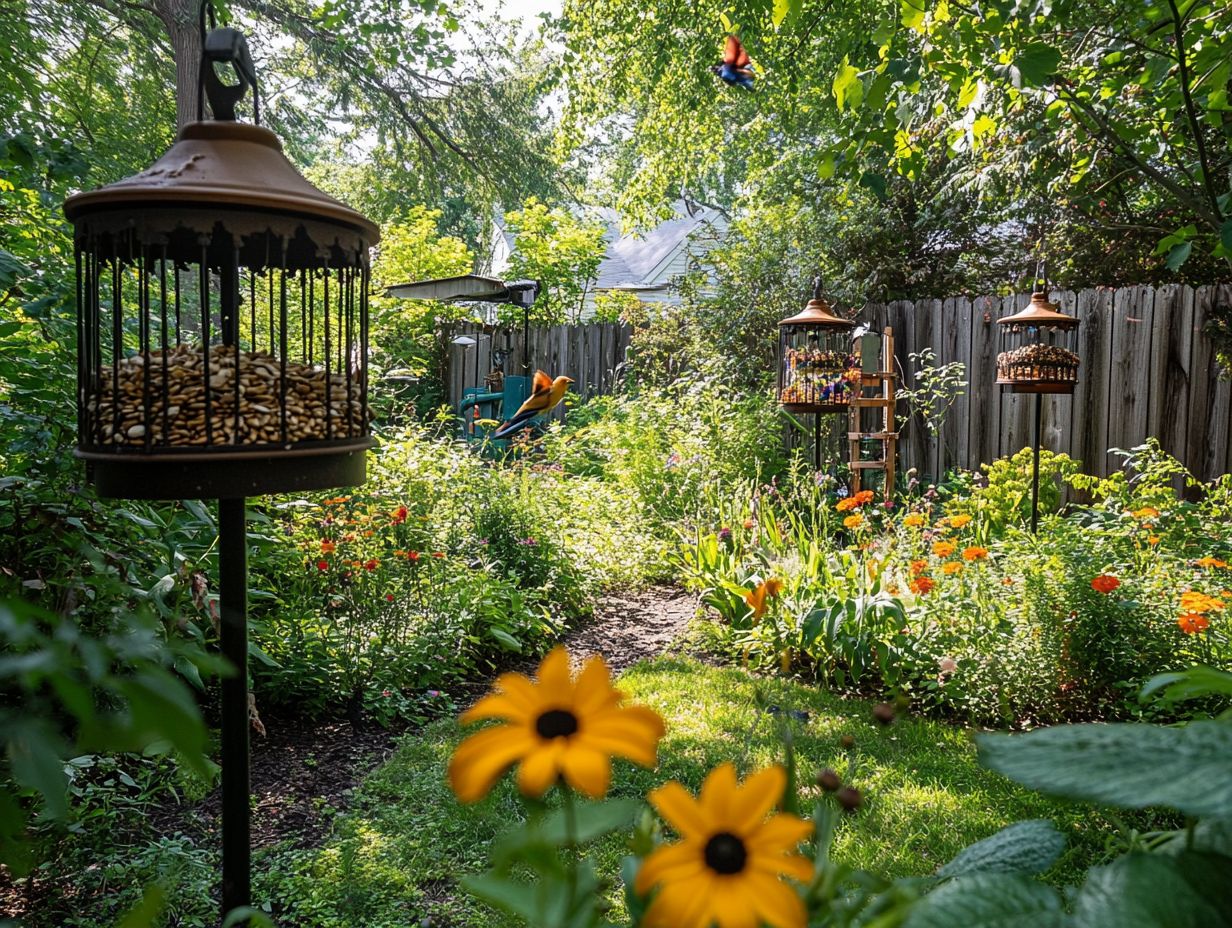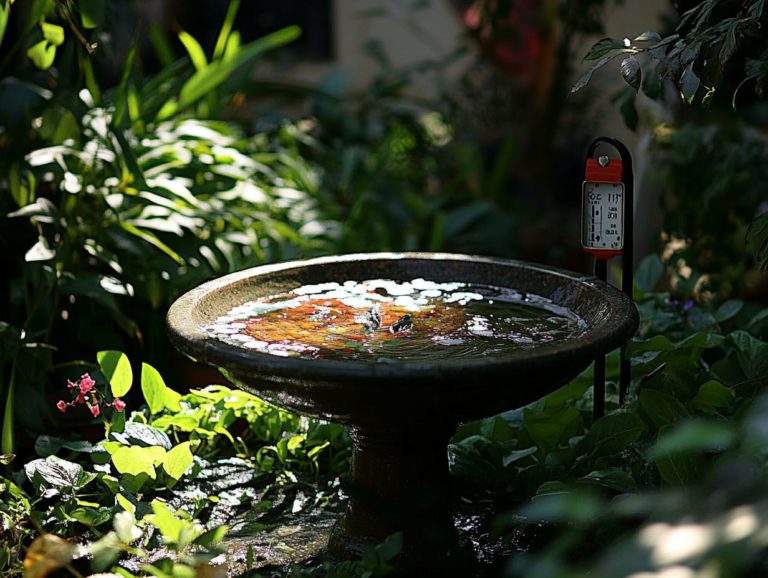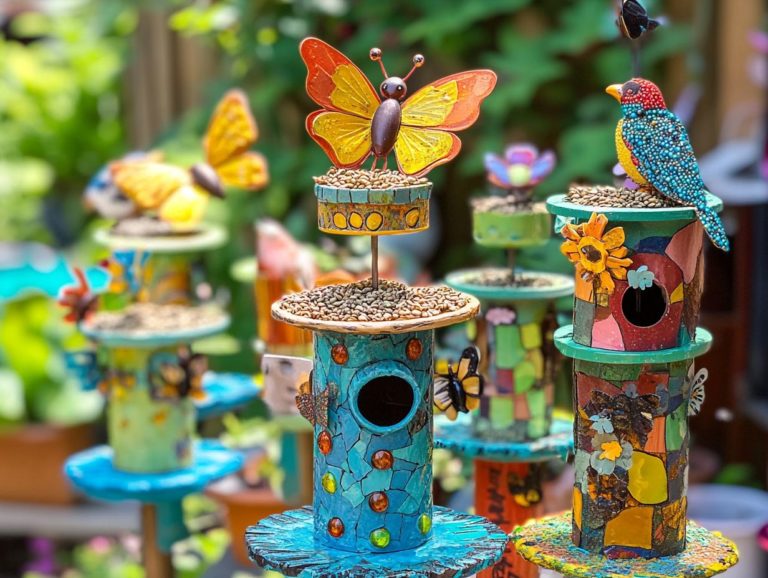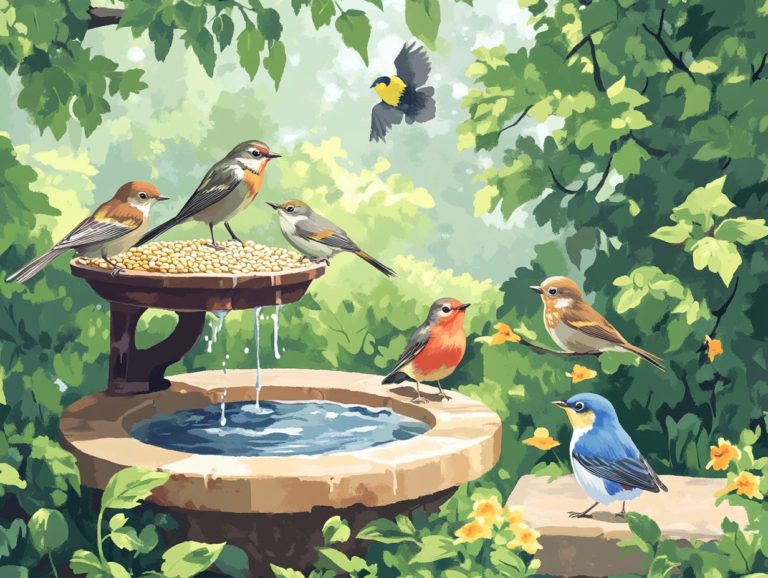Top Bird Feeding Tips for Beginners
Feeding birds is a delightful and rewarding experience.
It brings the beauty of nature right into your garden.
This article delves into the myriad benefits of bird feeding. You’ll uncover the various types of bird feeders available and learn how to select the right bird food for different species.
Discover bird feeding tips to attract your favorite birds. We also spotlight common mistakes to avoid, such as providing low-quality seed.
Embrace the opportunity to create a vibrant, bird-friendly environment around you, enriched by wildlife gardening practices!
Contents
- Key Takeaways:
- Benefits of Bird Feeding
- Types of Bird Feeders
- Choosing the Right Bird Food
- Attracting Specific Bird Species
- Common Mistakes in Bird Feeding
- Seasonal Considerations for Bird Feeding
- Frequently Asked Questions
- What are the top bird feeding tips for beginners?
- How often should I refill my bird feeder?
- Can I feed birds bread or other human food?
- Avoid These Common Pitfalls for Successful Bird Feeding!
- How Can I Attract Specific Bird Species to My Feeder?
- Want to Keep Your Feathered Friends Safe While Feeding? Here s What You Need to Know!
Key Takeaways:

Feeding birds has numerous benefits, including providing necessary nutrients and helping with pest control.
Choose the right feeder type to suit the needs of local garden birds.
Understanding the diet of different birds is crucial for selecting the right food.
Benefits of Bird Feeding
Bird feeding offers fantastic benefits! It enhances the health of local ecosystems and enriches your garden birdwatching experience.
It provides essential support to various bird species during critical periods, such as winter feeding and the breeding season.
By cultivating a bird-friendly garden equipped with suitable feeders and high-quality food think sunflower seeds and mealworms you can attract a remarkable diversity of garden birds.
This contribution enriches the local ecosystem.
Immersing yourself in birdwatching deepens your appreciation for nature and inspires wildlife gardening practices that benefit not only birds but also other wildlife in your area.
Why Feed Birds?
Feeding birds during the winter and breeding seasons is essential. It offers vital support when natural food sources and habitats become scarce.
In these challenging times, bird populations depend heavily on supplemental food to maintain their energy and health.
As temperatures drop, traditional sources of nutrition like seeds and insects can become increasingly elusive for our birds.
By understanding the dietary needs of local species, you can tailor your feeding strategies to provide a diverse and nutritious menu, which might include: sunflower seeds, mealworms, and fresh water.
- Seeds: A staple food for many birds.
- Suet: Packed with fat, perfect for winter feeding.
- Fruit: Attracts species like robins and mockingbirds.
Recognizing regional preferences will allow you to optimize your feeding stations, attracting a variety of birds and transforming your backyard into a vibrant, lively habitat.
Types of Bird Feeders
A diverse array of bird feeders is at your disposal, each meticulously crafted to meet the unique needs of various bird species and their food preferences.
By familiarizing yourself with the different bird feeder types, you can significantly elevate your backyard birding experience.
Different Feeder Designs and Their Advantages
Different feeder designs are tailored to serve unique purposes, allowing you to offer a variety of premium seeds and nutritious food sources that cater to the preferences of garden birds.
For instance, tube feeders are perfect for attracting clinging birds like finches and chickadees, as they effectively prevent larger birds from hogging the feeding area.
Conversely, hopper feeders can hold a larger quantity of seeds, drawing in a wider range of species, including jays and cardinals, making them ideal for seasonal feeding.
Meanwhile, platform feeders provide a versatile surface that accommodates various types of bird food, such as suet and fruits.
They are irresistible to everything from sparrows to woodpeckers, enhancing your birdwatching experience.
By thoughtfully selecting and positioning these feeders, you can significantly enhance the diversity of birds flocking to your outdoor spaces and encourage healthy birds to visit.
Start feeding birds today and transform your backyard into a lively habitat for these beautiful creatures!
Choosing the Right Bird Food

Selecting the right bird food is crucial for the health of the birds in your backyard. High-quality ingredients like sunflower seeds, mealworms, and wild bird food attract a variety of species and meet their nutritional needs.
Understanding Different Bird Diets
Birds have different diets and food preferences. Some thrive on seeds, while others eat insects or nectar.
For example, finches and sparrows enjoy a mix of sunflower seeds and millet, especially in winter when food is scarce.
Insect-eating birds like robins and warblers need high-protein food during breeding season. Hummingbirds flock to sugar water feeders and blooming flowers in spring and summer.
Adjusting your food offerings with the seasons invites more bird species to your garden.
Attracting Specific Bird Species
Bringing specific bird species to your garden is achievable with thoughtful strategies. Choose the right feeders and food types while adding bird-friendly plants.
These choices can transform your garden into a sanctuary for birds, enhancing your birdwatching experience.
Tips for Attracting Desired Birds
To attract specific birds, focus on feeder placement, provide a reliable water source, and create a seasonal feeding plan.
Place feeders near trees or shrubs to give birds cover from predators. This helps them feel safe while they eat.
Maintain a consistent water source, especially during warmer months. Birds need hydration to thrive.
Adjust feeding practices seasonally. Offer high-energy foods in winter and a variety of seeds in spring and summer to meet their needs.
Incorporating native plants will create a welcoming habitat, providing natural food and shelter for various birds.
Common Mistakes in Bird Feeding
Knowing common bird feeding mistakes helps maintain bird health. Avoid harmful practices like providing low-quality seeds or neglecting feeder maintenance.
By prioritizing quality and hygiene, you create an inviting space that supports the well-being of these beautiful creatures.
Avoiding Harmful Practices

Avoiding harmful practices in bird feeding, such as opting for low-quality seed or neglecting feeder maintenance, is essential for ensuring the well-being of your visiting birds.
When you fill your feeders with low-quality food, you risk causing malnutrition, which means birds don t get the nutrients they need. These birds require a balanced diet to truly thrive. Low-quality seed often contains fillers that offer little nutritional value, jeopardizing their health over time.
Dirty feeders can become breeding grounds for bacteria and mold, potentially sparking disease outbreaks among bird populations. Make cleaning your feeders a priority to keep your birds healthy! Select high-quality bird food tailored to meet the diverse dietary needs of your feathered visitors, ensuring they receive nutritious food.
By making these small adjustments, you can create a healthier environment that promotes vitality and longevity for your beloved avian friends. Start making these changes today for a happier garden full of vibrant birds!
Seasonal Considerations for Bird Feeding
Seasonal considerations are crucial for bird feeding and understanding the specific needs of various bird species. Each time of year requires tailored strategies to ensure you provide the right food supply.
This supports the health of birds during both the winter feeding period and the breeding season while considering local bird migration. By adapting your approach to align with these seasonal needs, you can create an environment that fosters the well-being of your feathered friends year-round.
Adjusting Feeding Habits Throughout the Year
Adjusting your feeding habits throughout the year to meet seasonal needs is essential for nurturing healthy birds in your garden.
As the seasons shift, different bird species make their appearance, each with unique food preferences that play a crucial role in their survival and reproductive success, especially during the breeding season.
For example, during winter, providing high-energy foods like suet or peanut butter can help finches and woodpeckers maintain their energy levels in the cold winter months.
When spring arrives, you’ll notice an influx of insect-eating birds think warblers and swallows who thrive on protein-rich offerings and help maintain the balance of your garden s ecosystem.
By presenting a diverse array of foods and incorporating seasonal varieties such as seeds, fruits, and mealworms, you can cater to the specific needs of various species throughout the year. This thoughtful approach ensures that the birds in your garden thrive and fosters a vibrant, lively atmosphere that brings your outdoor space to life.
Frequently Asked Questions
What are the top bird feeding tips for beginners?
- Choose the right feeder: Different bird species prefer different types of feeders, so research which feeder will attract the birds you want to see.
- Offer a variety of food: Birds eat different foods, so make sure to offer a mix of seeds, suet, and fruits to attract a diverse group of birds.
- Keep feeders clean: Dirty feeders can harbor bacteria and mold, which can be harmful to birds. Clean your feeders regularly to maintain a healthy feeding space.
- Place feeders in safe locations: Make sure to place feeders in areas that are safe from predators and protected from harsh weather conditions.
- Use the right seed: Avoid using cheap birdseed mixes, as they often contain fillers that birds won’t eat. Invest in high-quality, specific seeds for the birds you want to attract.
- Keep water available: Birds need water for drinking and bathing, so provide a shallow dish or birdbath for them to access.
How often should I refill my bird feeder?

It’s best to refill your bird feeder every 2-3 days, or sooner if you notice that it’s empty. This will ensure that birds have a continuous supply of food and will also prevent the seed from getting moldy.
Can I feed birds bread or other human food?
No, feeding birds bread or human food is not recommended.
These foods do not provide the necessary nutrients for birds and can be harmful to their health.
Avoid These Common Pitfalls for Successful Bird Feeding!
Some common mistakes include using cheap mixtures of seeds designed specifically for birds, not cleaning feeders regularly, and placing feeders in unsafe locations.
Additionally, ensure you provide enough variety in food options.
How Can I Attract Specific Bird Species to My Feeder?
Research the preferred food and feeder type for the specific bird species you want to attract.
Add plants and water sources that attract certain birds.
Want to Keep Your Feathered Friends Safe While Feeding? Here s What You Need to Know!
Make sure to keep your feeders clean to prevent the spread of diseases among birds.
Be mindful of placing feeders in areas that are safe from predators and avoid overcrowding to prevent the spread of illnesses.






